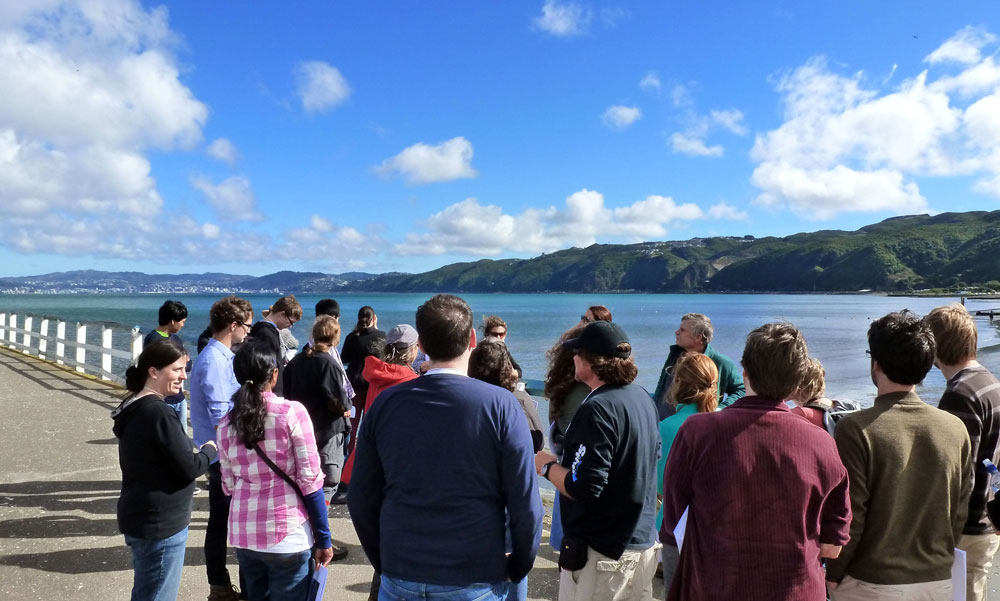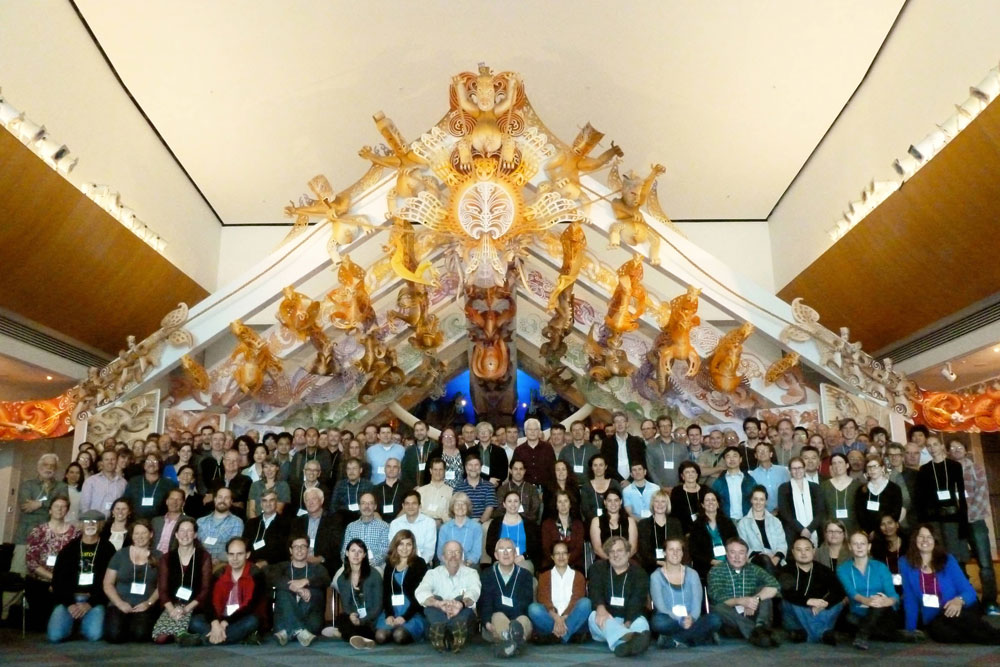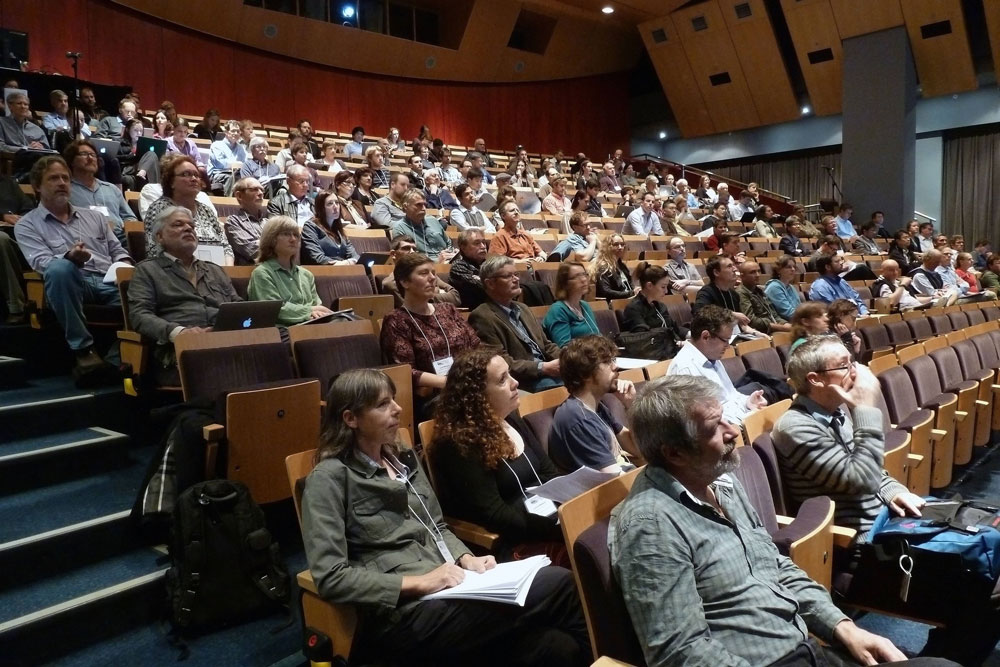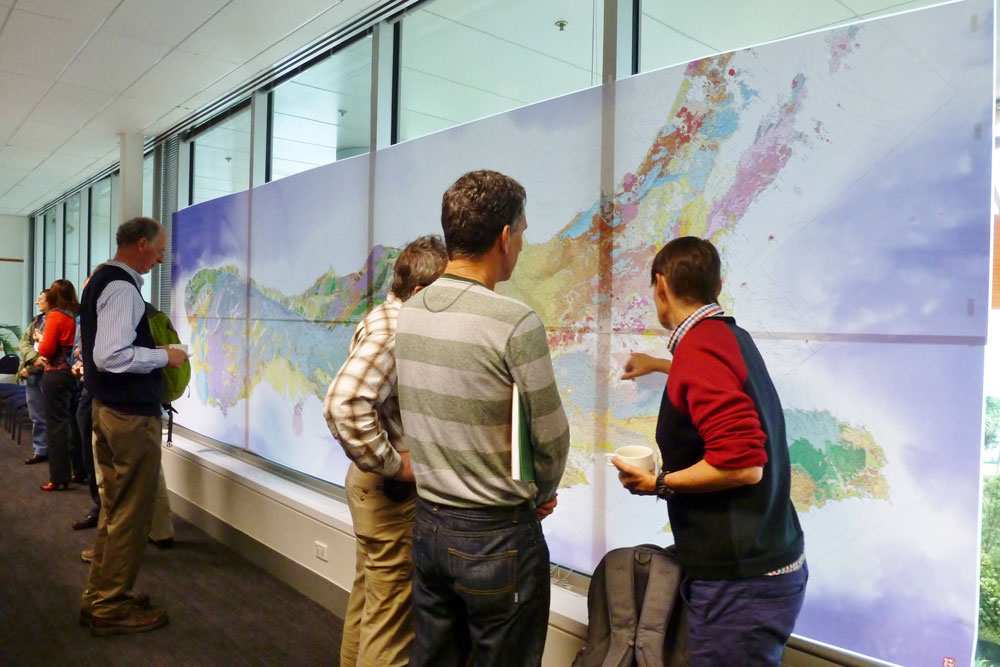Wellington, New Zealand, April 14-16 2012
1University of Texas, Austin; 2GNS Science, New Zealand; 3Oregon State University; 4California State University at Northridge; 5Cal Poly Pomona; 6Pennsylvania State University; 7University of California, Santa Cruz; 8NIWA, New Zealand
An implementation planning workshop was held for the New Zealand Primary Site on 14-16 April, at Te Papa Museum in Wellington, New Zealand. There were ~170 participants from ten different countries, demonstrating the outstanding opportunities for international collaboration at this Primary Site. The large number of participants and high-quality white papers submitted (38 white papers – more than for any of the other GeoPRISMS Primary Site Workshops) reflected the high level of enthusiasm among both the US and international subduction zone communities for future studies in New Zealand. The workshop consisted of a number of keynote and invited talks, and break-out sessions to discuss and prioritize the main scientific objectives and most suitable GeoPRISMS goals.
Workshop topics and agenda
After a welcome to the workshop from Prue Williams (New Zealand Ministry for Business, Innovation, and Employment), Kelvin Berryman (New Zealand Natural Hazards Platform), Bilal Haq (NSF) and Julia Morgan (GeoPRISMS Program), the science program kicked off with a keynote presentation from Nick Mortimer (GNS Science) on the history of subduction in New Zealand since the Paleozoic. For much of the remainder of the first day, we heard from keynote speakers on the four main topics to be addressed at the New Zealand Primary Site. These include:
- What are the geological, geochemical and geophysical responses to subduction initiation and early arc evolution and how do they affect subduction zone formation?
- What are the pathways and sources of magmas and volatiles emerging in the arc and forearc, and how do these processes interact with upper plate extension?
- What controls subduction thrust fault slip behavior and its spatial variability?
- What are the feedbacks between climate, sedimentation, and forearc deformation?
The keynote talks provided background on how these questions could be addressed in New Zealand, as well as global perspectives on the important outstanding questions. Keynote talks on the first day helped to set the stage for discussions held during the rest of the workshop. On the afternoon of Day 1, we held our first set of breakout sessions. The sessions were organized around the four key topics above, and were focused on identifying the most exciting science that can be done in New Zealand to address these topics.
At the beginning of the second day, the breakout session leaders reported back to the rest of the workshop on the outcomes of their breakout session discussions. Following the breakout leader reports, we heard a series of talks on existing infrastructure and datasets in New Zealand that could be brought to bear on any future GeoPRISMS studies at the New Zealand Primary Site. The range of datasets and available infrastructure at the New Zealand Primary Site is particularly impressive. Among these are comprehensive cGPS and seismic networks (www.geonet.org.nz), extensive, high-quality marine geophysical data that is publicly available, recent geological mapping of the entire country at a 1:250,000 scale, and a world-class database of active faults. Participants also heard about IODP projects and proposals that are in the works for the New Zealand region that have strong relevance to the SCD topics.
- Drilling at the offshore Hikurangi subduction margin to understand slow slip events,
- Drilling in the Lord Howe Rise area between New Zealand and Australia to investigate the consequences of Tonga-Kermadec-Hikurangi subduction initiation, and
- Drilling at Brother’s Volcano in the Kermadec Arc to understand submarine volcano hydrothermal processes.
After lunch on Day 2, we were also reminded of the potentially important societal implications of future GeoPRISMS SCD research in New Zealand by a series of talks on the role of science in the understanding of seismic (Russ Van Dissen, GNS Science), volcanic (Gill Jolly, GNS Science), and tsunami hazards (David Johnston, Massey University) in the New Zealand region. These talks were followed by a series of short, topical science talks on a variety of studies being undertaken in New Zealand and elsewhere to address questions relevant to the GeoPRISMS SCD. For the rest of the afternoon on Day 2, participants divided into four breakout sessions that represented the four main geographical areas of the New Zealand Primary Site:
- Hikurangi Margin,
- Fiordland,
- Kermadec Arc, Havre Trough, and vicinity,
- The Taupo Volcanic Zone.
These breakout sessions discussed the main science priorities in each of these geographic areas, and identified data gaps that need to be filled to undertake the science. Synergies that exist across the four Topics in each of these locations were also discussed.
At the beginning of Day 3, we heard reports from the Day 2 breakout leaders, and had a plenary discussion on the Day 2 outcomes. Following the reports, we heard a series of talks from potential international partners in Japan (Shuichi Kodaira, JAMSTEC), Germany (Achim Kopf, Bremen), the UK (Lisa McNeil, Southhampton), and Canada (Kelin Wang, Pacific Geoscience Center) about their countries’ ongoing research interests in subduction and the potential infrastructure that they could bring to bear on studies at the New Zealand Primary Site. Bilal Haq also gave an overview on the structure of GeoPRISMS, and potential NSF infrastructure, such as marine geophysical vessels, that could be utilized for NSF-funded studies in New Zealand. One of the most exciting aspects of the New Zealand Primary Site is the huge potential for US collaboration with New Zealand and other international partners which will greatly amplify the outcomes of any GeoPRISMS-funded studies conducted in New Zealand.
The remainder of the final day was spent in Breakout sessions and plenary discussions to refine the plans for future GeoPRISMS-funded studies within the main geographic focus areas. For the final set of breakout sessions, the conveners decided to stray from the original plan and organized the breakouts into geographic regions (rather than topically), so that the participants could focus in on planning for the main experiments to be conducted at the New Zealand Primary Site. One very controversial decision by the conveners was to put the Hikurangi and Taupo Volcanic Zone participants together in a single breakout session to discuss potential corridors across from the subduction thrust through to the arc to consider the Hikurangi subduction zone as a complete system. Although forcing these two groups together was a challenge, we hope that it initiated some discussions that will lead to more thinking about the Hikurangi subduction zone as a complete system in the future.
Identification of geographic corridors and priorities within those corridors
Four geographic regions emerged as focus areas where several of these topics could be well addressed.
The Puysegur Trench
The Puysegur Trench elicited significant enthusiasm at the workshop, as it is arguably the best-expressed example on Earth of a subduction zone being “caught in the act” of initiating, providing a globally unique opportunity to define the geodynamic boundary conditions to test models for subduction intiation. Key questions include: How does the new slab first enter the mantle? What is the fluid expression and thermal structure of subduction initiation? Focused geophysical surveys can tackle fundamental questions about the onset of convergence and associated vertical motions, offshore thermal and crustal structure, newly developing arc volcanism, as well as the geometry of subduction initiation. These new datasets will be underpinned by the uniquely well-constrained plate kinematic history during subduction development and a complete Miocene rock uplift history onshore Fiordland that records the vertical deformation response to subduction intiation.
The Hikurangi subduction margin
The Hikurangi subduction margin offers an outstanding opportunity to address the controls on variability in megathrust slip behavior, due to strong along-strike variations in interseismic coupling and slow slip event behavior observed there. Participants also recognized the outstanding opportunities to assess feedbacks between climate, sedimentation and forearc deformation, which can build upon previous MARGINS S2S studies in the Waipaoa catchment. Other questions to be addressed at Hikurangi include: How do topography, thermal structure, and material properties of incoming plate control fault zone structure, slip behavior, accretionary wedge evolution, and uplift and erosion of the forearc? What are the pathways and timescales of sediment input? What is the slip behavior and rheology of the near-trench portion of subduction fault?
Discussions for future work emphasized integrated geophysical, geological, and geochemical studies of the onshore and offshore forearc and incoming plate to discern the major controls on variations in subduction interface behavior and overall margin evolution. Moreover, a series of IODP proposals are currently in the system to investigate the mechanisms behind shallow slow slip event occurrence at North Hikurangi, and these provided an important focal point for discussions on future studies. Future studies at Hikurangi will leverage on existing datasets and scientific infrastructure such as a comprehensive geodetic and seismic network (www.geonet.org.nz), as well as significant ongoing and planned efforts by international partners in NZ, Japan, and Europe.
The Taupo Volcanic Zone
The Taupo Volcanic Zone elicited significant excitement as the most productive rhyolitic system on Earth, which also coincides with an extensional fault system. Some of the major questions to be addressed there include: How does the mafic flux from the mantle translate to voluminous rhyolitic magma production? How does arc volcanism interact with upper plate extension? World-class datasets bearing on the distributions, age, geochemistry, physical volcanology and petrology of many rocks from the Taupo and adjacent arc volcanoes have already been acquired by New Zealand-based researchers. As a result, substantial scope exists to supplement and synthesize these data and combine them with integrative geophysical and geochemical investigations. Moreover, comparison of the Kermadec Arc corridors with outcomes from the TVZ affords an opportunity to assess the influence of the continental/oceanic crust transition in the overlying plate on arc development, as well as changes in the nature of the subducting plate. An opportunity to link with the Hikurangi margin group also exists, and a targeted geochemical, geophysical, and geological corridor would enable assessment of controls on magmatism and volatile cycling for the entire subduction system, from the incoming plate and forearc through to the arc.
The Kermadec Arc
The Kermadec Arc offers a prime setting for addressing questions relating to magmatic and volatile fluxes at a well-developed volcanic arc from the forearc through to the backarc. The Havre-Lau backarc system, which progresses from oceanic spreading in the north to rifting and disorganised spreading in the south, also offers insights into backarc extension dynamics and the reorientation of arc systems. The effect of Hikurangi Plateau subduction on the magmatic products of the arc is also a topic of interest, requiring some along-strike comparisons. Moreover, it was also recognized that an outstanding record of Eocene subduction initiation at the Tonga-Kermadec-Hikurangi Trenches exists in the region west of the Kermadec Trench. The Kermadec Arc working group recognized that a key initial part of the project will be to identify corridors across the arc in which to target their field programs. Targeted field programs would include shipboard geophysics (passive and active seismic, electromagnetic, among others), rock sampling for geochemistry, petrology, and chronology, and hydrothermal fluid sampling. Results from an upcoming GeoMar/Sonne cruise in the Kermadec Arc will provide results to help define which corridor(s) should be focused on. The marine-based science plan developed by a Kermadec working group would complement ongoing and planned efforts by New Zealand, Japanese and German colleagues, and these international collaborations will amplify outcomes of GeoPRISMS goals in the Kermadec Arc.
In addition to these geographically-focused efforts, there was strong support for GeoPRISMS studies of exhumed terranes in New Zealand, which provide unique exposures of Mesozoic subduction in the Fiordland and Otago regions of the South Island, as well as parts of the eastern North Island. It was recognized that the only pristine Cretaceous arc section in the Circum-Pacific exists in Fiordland in the South Island, offering a prime locale to investigate the root zones of an ancient arc, at outcrop scale.
International Collaborations
The New Zealand Primary Site already is the focus of significant research efforts within the international community. This affords a wide range of opportunities for linking GeoPRISMS studies with a vast body of previous work on subduction systems in NZ, leveraging existing infrastructure, and collaboration in numerous ongoing and planned investigations. These ongoing endeavors include significant investments from the NZ government and efforts within the highly productive NZ geosciences community, as well as active research programs led by Japanese and European- based investigator groups. Any GeoPRISMS studies in New Zealand should build on these substantial existing and ongoing studies. We were pleased to see concrete plans for future experiments develop between the international partners and US investigators during the workshop. Although the science priorities identified at the New Zealand Primary Site are many and varied, we expect that most of these can be realistically accomplished due to the additional resources of the broader, international community that can be brought to bear on these topics.

Figure 4. Students gathered around Nicola Litchfield and Tim Little at Petone Wharf – Upper Hutt. Major uplift of the Wellington Basin occured after the 1855 Wairarapa Earthquake.
Student Participation
20 students from the US, New Zealand, and the United Kingdom participated in the workshop. A student symposium was held the day before the workshop, on the campus of Victoria University in Wellington. A series of talks were given by some of the conveners and other invited scientists to introduce the students to the New Zealand subduction setting and outline the GeoPRISMS scientific goals. The students brought posters on their research which they each presented to the group in two minutes pop-up talks. The student presentations were extremely informative and polished. On the last day of the main workshop awards for poster presentation were given to 6 students (Best Overall Poster & Presentation: Katie Jacobs, Besim Dragovic, Melissa Rotella; Honorable Mention for Verbal Presentation: Laurel Childress; Honorable Mention for Poster Layout & Visual Aesthetics: James Muirhead, Simon Barker). After the student symposium, Tim Little (Victoria University) and Nicola Litchfield (GNS Science) led an outstanding fieldtrip to see the Wellington Fault (an active dextral strike-slip fault) at various locations throughout the Wellington region.
Overall, the extremely high level of engagement and input at the workshop by the students was impressive. On the final day, the students presented a well-organized implementation plan for the New Zealand Primary Site, which was a valuable guide in the crafting of the final implementation plan.
Concluding Remarks
We would like to thank the meeting attendees for their enthusiastic participation, which made the workshop a great success. We would also like to thank the speakers for the stimulating and informative talks, and the breakout leaders for their key role in steering discussions. The white paper authors made major contributions by sharing their ideas for future work, which have also provided an important resource for development of the draft implementation plan. The enthusiastic participation of the graduate students and post-docs was extremely impressive, and bodes well for the future of subduction studies in the New Zealand region. The draft implementation plan has been released for public comment, and should be finalized by the end of the year, if not sooner, well in time for the upcoming GeoPRISMS NSF deadline of July 1, 2014. Finally, a successful workshop would not have been possible without generous financial support from NSF/GeoPRISMS, the New Zealand Ministry for Business, Innovation and Employment, the Consortium for Ocean Leadership, GNS Science, and the New Zealand Earthquake Commission.



